The Army Air Force’s Missing Air Crew Reports were instituted in May of 1943 to provide a system for the documentation and organization of information covering aircraft and personnel reported missing on Army Air Force operational missions, the ultimate goal being the conclusive determination of the fate of such missing personnel. Though these documents show notable variation in style and format depending upon the immediate organization filing the report*, the “elements” of information within them remained highly consistent throughout the war. A thorough description of the implementation and use of the MACR system is presented in the National Archives and Records Administration’s (NARA) Publication M1380: Missing Air Crew Reports (MACRs) of the U.S. Army Air Forces, 1942-1947, available here.
Commencing with the de-classification of MACRs on September 10, 1982, historians, military aviation enthusiasts, and genealogists have been able to avail themselves of these documents, and the multi-faceted wealth of information within them. As such, a casual perusal of books published since the mid-1980s about the WW II Army Air Force – particularly unit histories – as well as a cursory web search, will quickly reveal the importance of these documents. They are now available in microfiche format at the National Archives and Records Center in College Park, Maryland, now digitally through Fold3.com, and in transcribed or other formats at many websites. When used with official Squadron and Group histories, they are an essential resource in the creation of accurate and comprehensive histories of combat units of the WW II Army Air Force.
Another series of documents, perhaps less widely known than Missing Air Crew Reports but complementary to them (specifically, those MACRs filed for USAAF losses in the European and Mediterranean Theaters) are the German Luftgaukommando Reports. These documents, held within NARA’s collection of Foreign Records Seized (Record Group 242), are reports on Allied aircraft lost in the European and Mediterranean Theaters of War. In terms of the information recorded with them, they are an ironic and accidental counterpart to MACRs. Though the extent of information in Luftgaukommando Reports shows very great variation, in a general sense, they include information about the nature and circumstances (flak or fighters) as to how an American aircraft was downed and recovered in German-occupied territory, the location and condition of its wreckage, technical aspects of the plane or its equipment particularly noted by German investigators, and, nominal biographical information about aircrew casualties.
A particularly notable aspect of Luftgaukommando Reports is that these documents not uncommonly contain material found in the possession of American airmen when they became casualties. The reports can include dog-tags, correspondence both to and from servicemen (V-Mail, and, typed or handwritten letters), official documents, and other items, such as navigational records or fragments of technical documents. Luftgaukommando Reports practically never include POW information / identification cards (“Personalkarte“ – “Personal Card“) created by the Germans about captured aviators – post capture. And, they don’t include POW identification photographs (“mug-shots”) of captured airmen typically attached to such cards.
In any event, far more than digitized, published, or secondary material, the content of Luftgaukommando Reports – documents carried by airmen – inevitably make one “pause” and reflect about the reality, nature, and impact of war.
A small fraction of the Luftgaukommando Reports include photographs of downed American aircraft.
Such material is the subject of this posting: A crash-landed P-51 Mustang of the 356th Fighter Squadron of the 354th Fighter Group, the “Pioneer Mustang Unit”.
The aircraft was piloted by Captain Gordon T. McEachron when it was downed by flak on December 1, 1944, near Niederkirchen, Germany.
Captain McEachron, from California, was originally assigned to the 380th Fighter Squadron of the 363rd Fighter Group (9th Air Force), in the service of which he scored three aerial victories in 1944 while a First Lieutenant: An Me-109 on April 30, another Me-109 on May 28, and an Me-410 on June 20.
An account of his victory of May 28 – from his Distinguished Flying Cross citation for his actions of May 28 – appeared in Steve Blake’s publication Fighter Pilots in Aerial Combat, in 1983, in a comprehensive six part series about the history of the 363rd Fighter Group.
The citation states: “Lt. McEachron was leading a Flight on a bomber escort mission when he spotted a large number of enemy aircraft overhead. He immediately ordered the Flight to drop their wing tanks and make a sharp turn to the left. By the time the Flight had completed the turn, the enemy aircraft could no longer be seen. Suddenly a break was called, and as Lt. McEachron turned, he saw more than 100 enemy planes approaching from the rear. Intercepting the group of Me-109s just as they were pressing their attack on the bombers, Lt. McEachron picked a target, closed to about 300 yards, and fired a long burst. Strikes were noted along the fuselage and wing, and the enemy aircraft rolled over and split ‘S’d’ with dense black smoke pouring from the engine.
“Suddenly an Me-410 appeared just in front of him. As the enemy turned, Lt. McEachron turned with him and fired a long burst. Strikes were observed along the fuselage of the enemy plane. Together with his wingman, Lt. McEachron went after the main group of enemy aircraft which were ahead. Another target, an Me-109, came into view. Lt. McEachron chased in on the enemy fighter and began firing from 500 yards. Pieces of the plane began to fly off as round after round went home. Suddenly black smoke began pouring from the plane and it caught on fire. The enemy pilot bailed out.”
Lt. McEachron was sent home on leave in August of 1944, and after his return to France as a Captain – at which time the 363rd Fighter Group no longer existed – was assigned to the 354th Fighter Group in November, as Assistant Operations Officer of the 353rd Fighter Squadron.
Captured and imprisoned at Stalag Luft I, Barth, Germany, Captain McEachron returned to the United States at the war’s end. According to his biography at FindAGrave.com and his Wikipedia entry, he coached college football at the University of Nevada, and, Pepperdine University (near Los Angeles) between 1953 and 1958. Later, he sold insurance. He died on April 22, 1993.
And now, time for some photographs and documents…
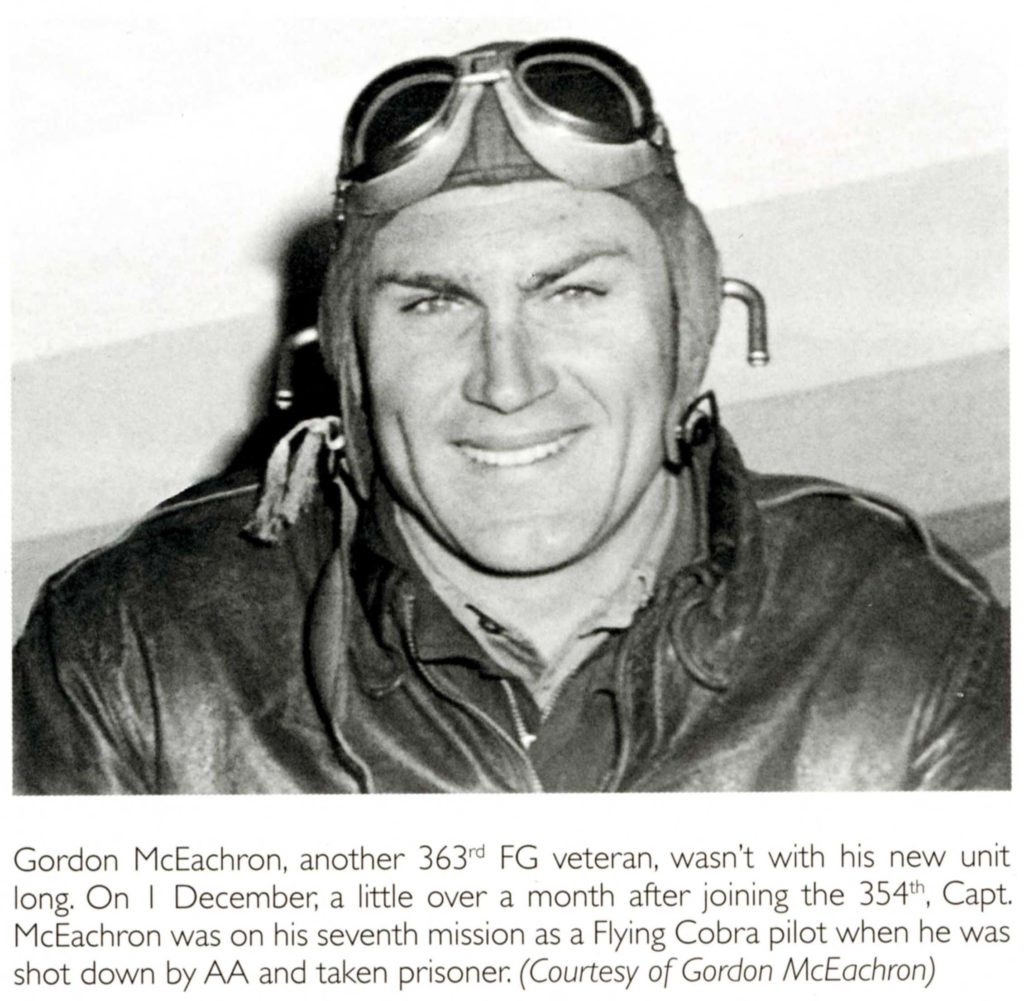 Captain McEachron, probably photographed while still in Stateside training, given that his flight helmet is equipped with Gosport Tubes. (From Steve Blake’s The Pioneer Mustang Group: the 354th Fighter Group in World War II.)
Captain McEachron, probably photographed while still in Stateside training, given that his flight helmet is equipped with Gosport Tubes. (From Steve Blake’s The Pioneer Mustang Group: the 354th Fighter Group in World War II.)
* * * * * * * * * *
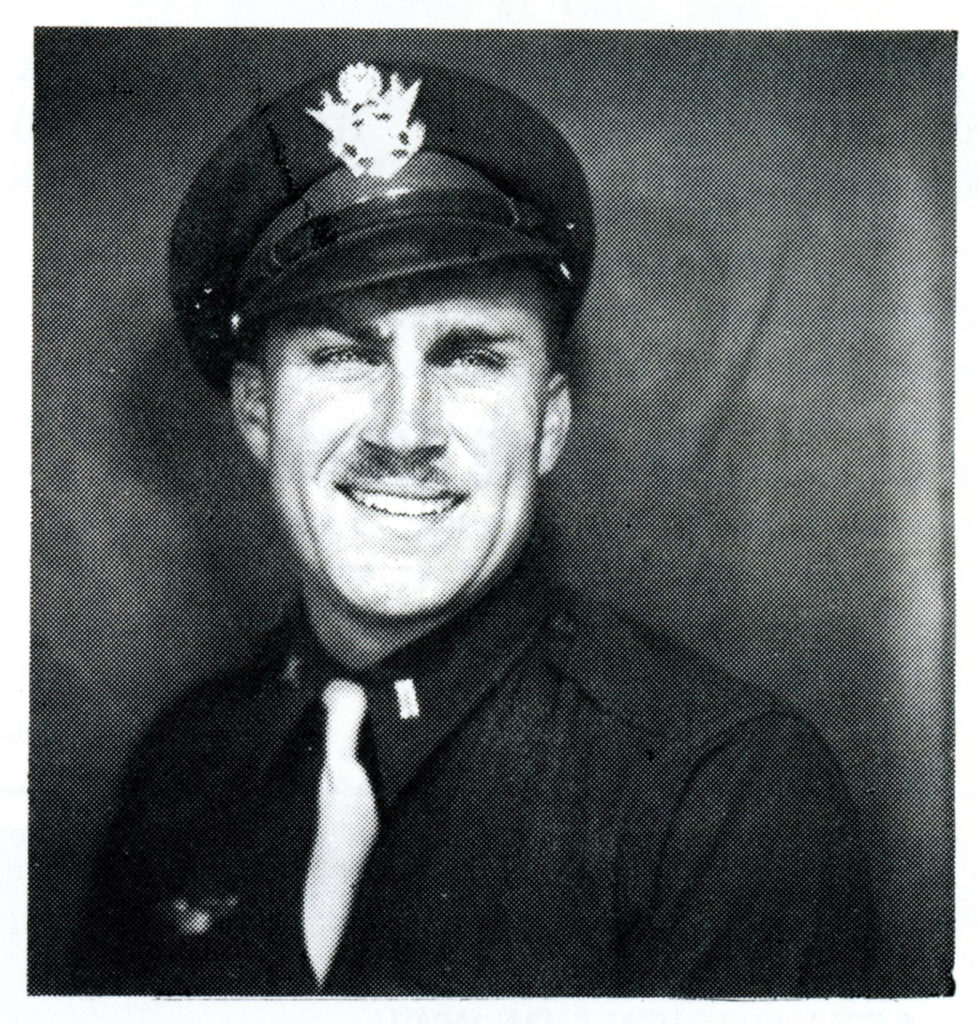 A portrait of then Lieutenant McEachron, from Fighter Pilots in Aerial Combat.
A portrait of then Lieutenant McEachron, from Fighter Pilots in Aerial Combat.
* * * * * * * * * *
 Gordon McEachron seated on the wing of his personal P-51B, Beachcomber II, while serving in the 363rd Fighter Group. He named the aircraft after a club he founded while a student at Pepperdine University. This image is reproduced from the book Mission 376: Battle Over the Reich, May 28, 1944, by Ivo De Jong.
Gordon McEachron seated on the wing of his personal P-51B, Beachcomber II, while serving in the 363rd Fighter Group. He named the aircraft after a club he founded while a student at Pepperdine University. This image is reproduced from the book Mission 376: Battle Over the Reich, May 28, 1944, by Ivo De Jong.
* * * * * * * * * *
 Additional views of Lt. McEachron in service with the 363rd Fighter Group, from Fighter Pilots in Aerial Combat. The upper photograph is another view of Beachcomber II, while the lower photograph shows Beachcomber III (with three kill markings) a P-51D he received in July of 1944.
Additional views of Lt. McEachron in service with the 363rd Fighter Group, from Fighter Pilots in Aerial Combat. The upper photograph is another view of Beachcomber II, while the lower photograph shows Beachcomber III (with three kill markings) a P-51D he received in July of 1944.
* * * * * * * * * *
And now, the subject of our study.
First, the Missing Aircrew Report (MACR 11479) filed by the 353rd Fighter Squadron after Captain McEachron failed to return to Saint Dizier, France.
Eyewitness account of loss of Captain McEachron and Chicago’s Own
Now, we come to the subject of our study: Images from Luftgaukommando Report “J-2525” covering P-51D 44-14010, AJ * G, otherwise known as Chicago’s Own…
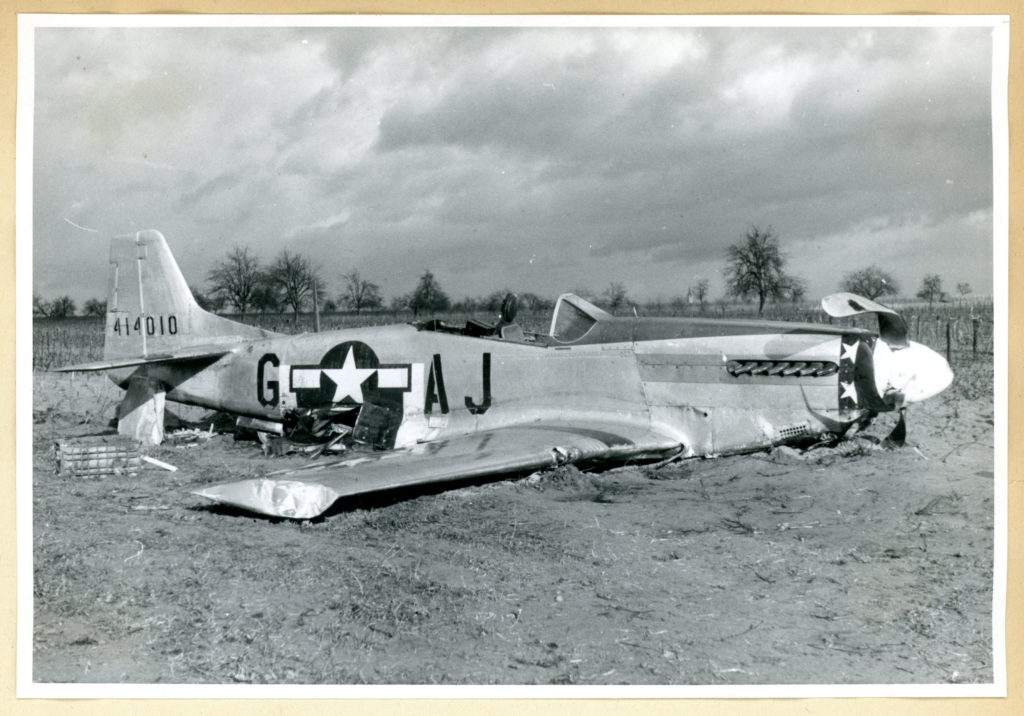 Right-front view of the Mustang, under an overcast but still sunny sky. Note that the aircraft’s coolant radiator has been removed from the fuselage.
Right-front view of the Mustang, under an overcast but still sunny sky. Note that the aircraft’s coolant radiator has been removed from the fuselage.
* * * * * * * * * *
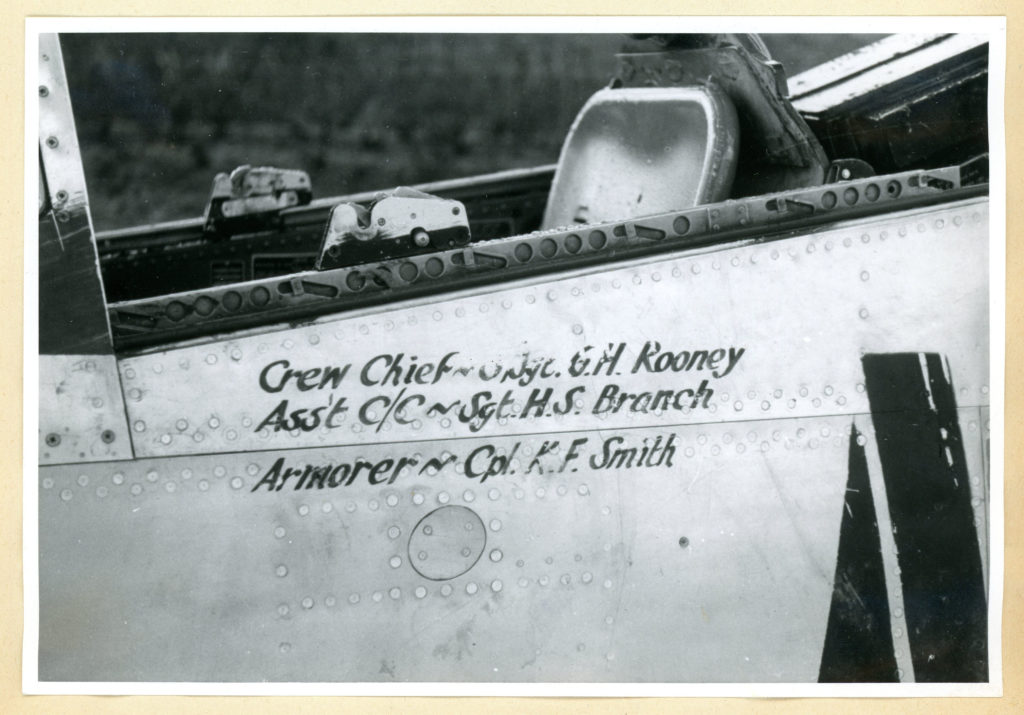 Close-up of canopy rails along left side of cockpit, with names of ground-crew (Rooney, Branch, and Smith) painted below. (Why photographs were not taken of equipment within the cockpit itself, is a matter of conjecture!)
Close-up of canopy rails along left side of cockpit, with names of ground-crew (Rooney, Branch, and Smith) painted below. (Why photographs were not taken of equipment within the cockpit itself, is a matter of conjecture!)
* * * * * * * * * *
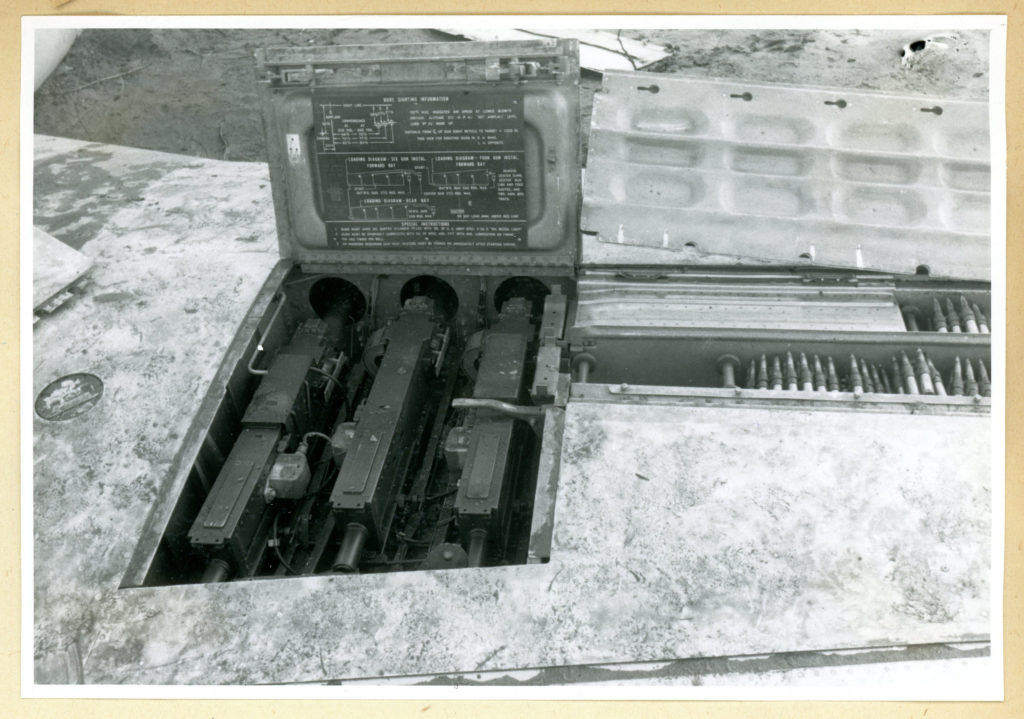 Starboard gun bay, providing an excellent view of the installation of the three fifty-caliber guns and firing selonoids. Belts of .50 caliber ammunition are still laying in ammuntion trays.
Starboard gun bay, providing an excellent view of the installation of the three fifty-caliber guns and firing selonoids. Belts of .50 caliber ammunition are still laying in ammuntion trays.
* * * * * * * * * *
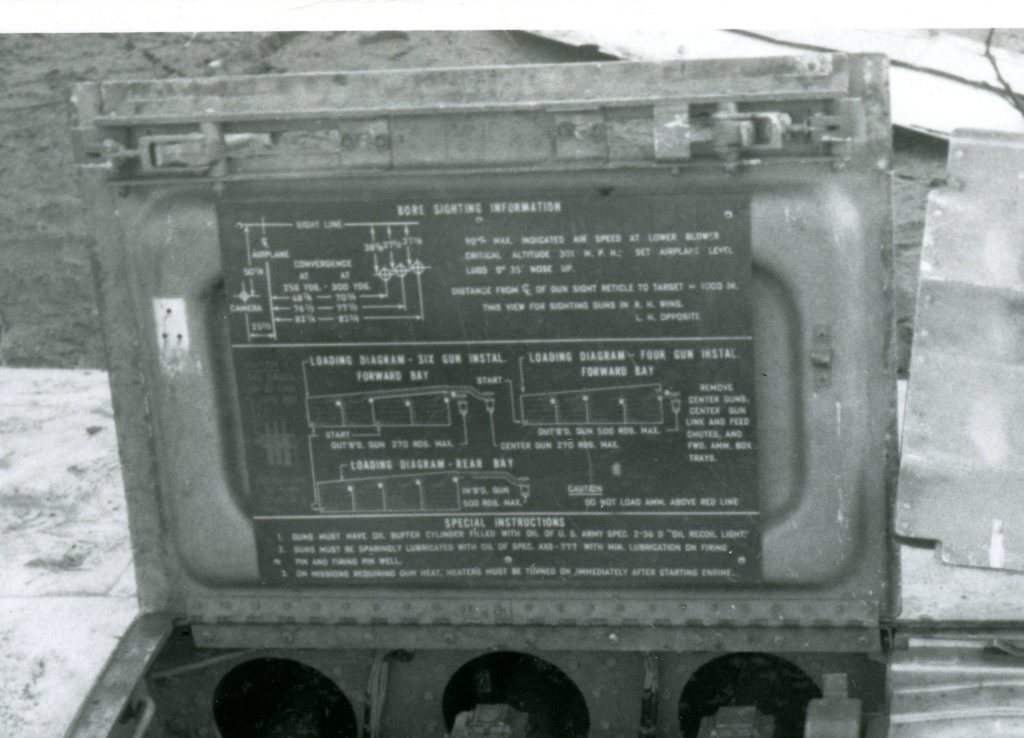 A very high resolution (800 dpi) scan of the above photograph, specifically of the placard attached to the interior of the gun-bay access door, showing bore-sighting information and ammunition loading diagrams. (This image will be of particular benefit for plastic modelers building Tamiya’s 1/32 P-51D while under the influence of AMS – “Advanced Modeler’s Syndrome”!)
A very high resolution (800 dpi) scan of the above photograph, specifically of the placard attached to the interior of the gun-bay access door, showing bore-sighting information and ammunition loading diagrams. (This image will be of particular benefit for plastic modelers building Tamiya’s 1/32 P-51D while under the influence of AMS – “Advanced Modeler’s Syndrome”!)
* * * * * * * * * *
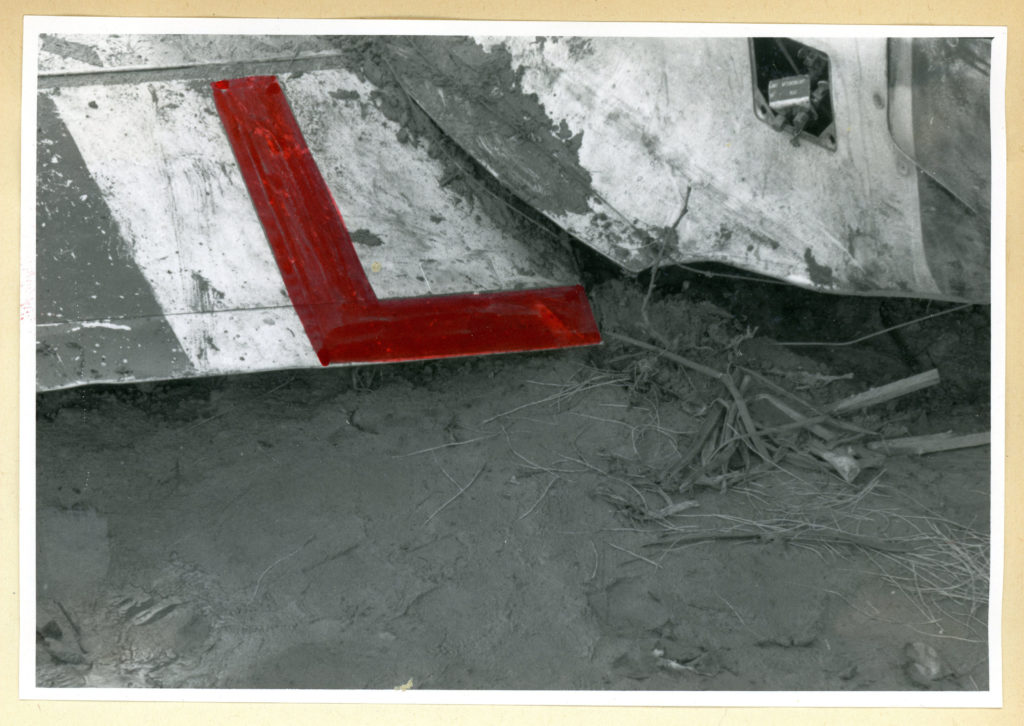 View of inboard section of the port flap. Curiously, though the photographs were taken with black & white film, the “No Step” marking appearing on the image of the flap has been colored with red ink, matching the color and shape of the marking on 44-14010.
View of inboard section of the port flap. Curiously, though the photographs were taken with black & white film, the “No Step” marking appearing on the image of the flap has been colored with red ink, matching the color and shape of the marking on 44-14010.
* * * * * * * * * *
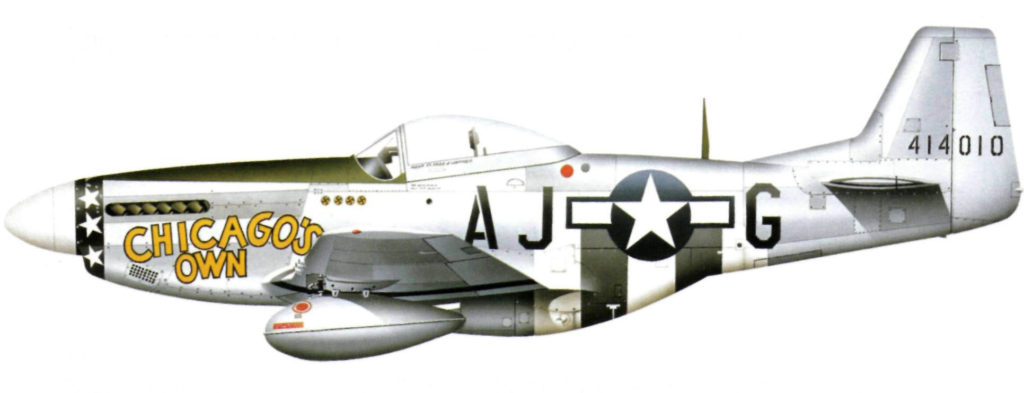 Images of Chicago’s Own (a color profile, and an official USAAF photograph of the aircraft at Debden, England) can be found in William Hess’ book 354th Fighter Group, The aircraft is described as having been the personal plane of Lt. Frederick J. Warner. The above color profile of Chicago’s Own, by Chris Davey or John Weal, appears on page 41 of Hess’ book.
Images of Chicago’s Own (a color profile, and an official USAAF photograph of the aircraft at Debden, England) can be found in William Hess’ book 354th Fighter Group, The aircraft is described as having been the personal plane of Lt. Frederick J. Warner. The above color profile of Chicago’s Own, by Chris Davey or John Weal, appears on page 41 of Hess’ book.
The USAAF photograph of 44-14040, dated October 6, 1944, can be found at the website of the American Air Museum in Britain.
* * * * * * * * * *
The “Meldung über den Abschuss eines US-amerikanischen Flugzeuges” (Notification About the Shooting Down of a U.S. Aircraft) form – commonly found in Luftgaukommando Reports – filed for Captain McEachron and Chicago’s Own.
The data fields in the form covering the aircraft comprise:
Abschusstag und Zeit: Date and time of shooting down
Abschussort: General location of shooting down
Flugzeugtyp: Aircraft type
Meldende Dienstelle: [Location of] Reporting Service
The data fields in the form covering the aviator comprise:
Name und Vornamen / Geburststag und –ort: Name and first name / Date and place of birth
Dienstgrad: Rank
Erk.-Marke: Tag number
Gef: [Gefangenen]: (prisoner? [if so]) – Welches Lager: Which camp
Verw: [Verwundet]: (wounded? [if so]) – Art d. Verwundung: [?]
Tot: [Tot]: (killed? [if so]) – Grablage: Grave Location
And, at the bottom of the form:
Bemerkungen: Remarks
* * * * * * * * * *
The same form was typically used in Luftgaukommando Reports to cover aircrews of multi-place aircraft.
This is a Luftgaukommando Report (KU 3493) crew list for a multi-place aircraft. In this case, B-17G 43-97215 (BG * J) of the 334th Bomb Squadron, 95th Bomb Group, piloted by 2 Lt. Stewart D. Reed, which was lost on December 31, 1944. There were five survivors of the plane’s nine crewmen, covered in MACR 11368.
* * * * * * * * * *
I hope that readers find these images of interest. I may be able to post similar images in the future.
*Particularly distinctive in format are MACRs filed by the 15th Air Force’s 483rd Bomb Group.
– References –
Books
Blake, Steve, The Pioneer Mustang Group: the 354th Fighter Group in World War II, 2008, Schiffer Military History, Atglen, PA.
De Jong, Ivo, Mission 376: Battle Over the Reich, May 28, 1944, 2012 Stackpole Books, Mechanichsburg, PA.
Hess, William N., 354th Fighter Group, Osprey Publishing; 2002, Botley, Oxford, United Kingdom
USAF Historical Study No. 85, USAF Credits for the Destruction of Enemy Aircraft, World War II, 1978, Albert F. Simpson Historical Research Center, Air University.
Other Publications
National Archives and Records Administration, Missing Air Crew Reports (MACRs) of the U.S. Army Air Forces, NARA Publication M1380, 1942-1947, 2005, Washington, D.C.
Missing Air Crew Reports
https://www.fold3.com/title_95/missing_air_crew_reports_wwii#overview
http://www.archives.gov/research/military/ww2/missing-air-crew-reports.html
http://www.afhso.af.mil/questions/topic.asp?id=1934
https://www.archives.gov/research/microfilm/m1380.pdf
Luftgaukommando Reports (see comments by RodM) at:
http://www.rafcommands.com/archive/06732.php
J (Jäger) Report 2525
United States National Archives – Collection of Foreign Record Seized – Record Group 242: “Records of Luftgaukommandos: German Reports of Downed Allied Fighters and Other Aircraft – J (Jäger) Reports”
Report J-2525: (At) Records Group 242, Entry 1013, Shelf Location 190 / 14 / 9-8 / 2-1
Gordon T. McEachron
Blake, Steve, The 363rd Fighter Group in WW II (Part II), Fighter Pilots in Aerial Combat, Number 6, Fall, 1982, pp 13-23.
Blake, Steve, The 363rd Fighter Group in WW II (Part III), Fighter Pilots in Aerial Combat, Number 7, Winter, 1983, pp 15-22.
Blake, Steve, The 363rd Fighter Group in WW II (Part IV), Fighter Pilots in Aerial Combat, Number 9, Summer, 1983, pp 22-26.
Blake, Steve, The 363rd Fighter Group in WW II (Part V), Fighter Pilots in Aerial Combat, Number 11, Winter, 1985, pp 4-15.
http://findagrave.com/ (Search for entry under Gordon Townsand McEachron)
https://en.wikipedia.org/wiki/Gordon_McEachron
P-51D 44-14010
http://www.americanairmuseum.com/aircraft/14229
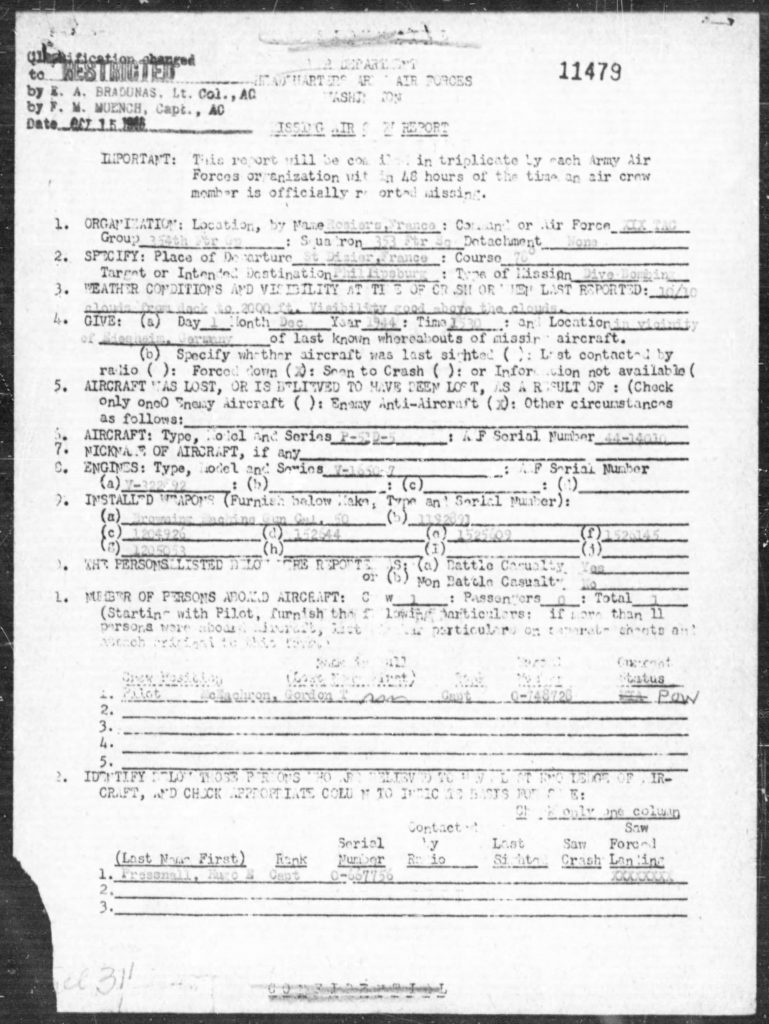
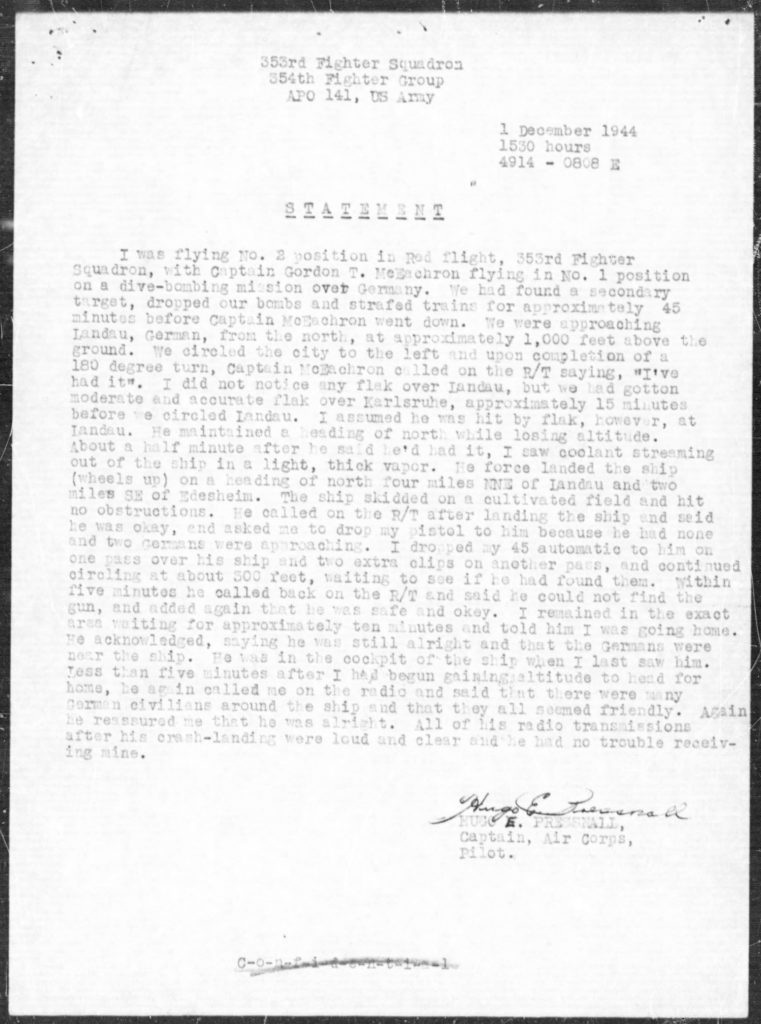
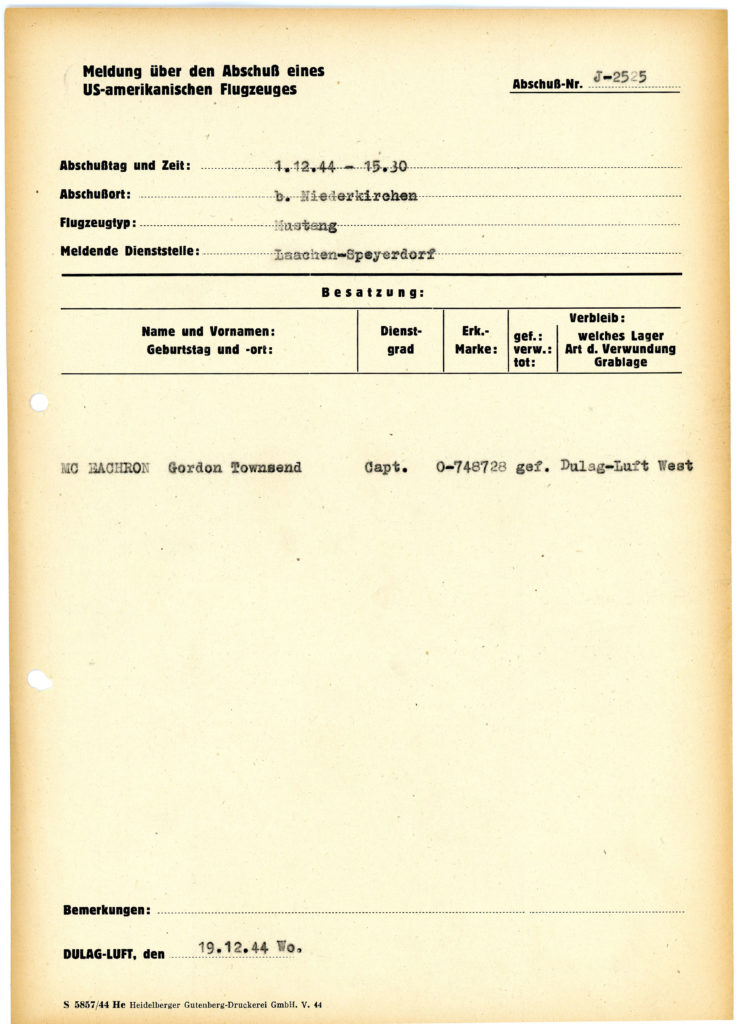

Deprecated: Function get_magic_quotes_gpc() is deprecated in /home3/emc2ftl3/public_html/wp-includes/formatting.php on line 4365
Deprecated: Function get_magic_quotes_gpc() is deprecated in /home3/emc2ftl3/public_html/wp-includes/formatting.php on line 4365
Deprecated: Function get_magic_quotes_gpc() is deprecated in /home3/emc2ftl3/public_html/wp-includes/formatting.php on line 4365